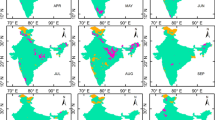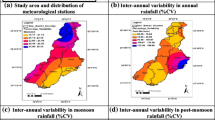Abstract
The paper analyzed the spatial-temporal variability of rainfall and detection of potential trend change point over Kosi River basin, Kumaon Lesser Himalaya, India, using long-term gridded data and historical metrological records in hilly river basin of Uttarakhand. The Mann-Kendall (MK) test was used to determine the spatio-temporal trend using IMD (0.25° × 0.25°) gridded rainfall data during 1901–2015. The Theil-Sen slope was used to determine the magnitude of change in rainfall during the study period. Additionally, the sequential Mann-Kendal (SQ-MK) test and Pettitt’s test has been used to find the abrupt change point in historical time series (1980–2019). Results of the study show that northeastern and southwestern parts of the Kosi River basin exhibit a statistically significant decreasing trend in both June and July months at 5% significance level. Northeastern and southwestern parts of the basin exhibit a statistically significant decreasing trend for monthly and annual rainfall. The range of Sen’s slope values varies from −0.6 to −6.6 mm/year. Based on the analysis of SQ-MK and Pettitt’s test, the change points for Almora, Mukteshwar, and Hawalbagh were 1991, 2004, and 1998 respectively. Therefore, this paper attempts to provide actionable knowledge for irrigation water planning, water management, and soil and water conservation for Uttarakhand.









Similar content being viewed by others
References
Banerjee A, Chen RE, Meadows M, Singh RB, Mal S, Sengupta D (2020) An analysis of long-term rainfall trends and variability in the Uttarakhand Himalaya using Google Earth engine. Remote Sensing 12(4):709
Barthlott W, Lauer WPA, Placke A (1996) Global distribution of species diversity in vascular plants: towards a world map of phylodiversity. Erdkunde 50:317–327
Basistha A, Arya DS, Goel NK (2009) Analysis of historical changes in rainfall in the Indian Himalayas. Int J Climatol: J R Meteorol Soc 29(4):555–572
Bera S (2017) Trend analysis of rainfall in Ganga Basin, India during 1901–2000. Am J Clim Chang 6(01):116
Bhagawati K, Sen A, Kalita H, Bhagawati R, Shukla KK (2018) Rainy days and rainfall intensity trends in Basar (Arunachal Pradesh) during 1979–2015. Mausam 69:427–432
Bharti V, Singh C, Ettema J, Turkington TAR (2016) Spatiotemporal characteristics of extreme rainfall events over the Northwest Himalaya using satellite data. Int. J. Climatology 36:3949–3962
Bhatt D, Maskey S, Babel MS, Uhlenbrook S, Prasad KC (2014) Climate trends and impacts on crop production in the Koshi river basin of Nepal. Reg. Environ. Chang. 14:1291–1301
Chakraborty A, Saha S, Sachdeva K, Joshi PK (2018) Vulnerability of forests in the Himalayan region to climate change impacts and anthropogenic disturbances: a systematic review. Reg. Environ. Chang. 18:1783–1799
Chow FK, Wekker SFD, Snyder BJ (eds) (2013) Mountain weather research and forecasting, recent progress and current challenges. Springer Atmospheric Sciences. ISBN 978-94-007-4098-3. https://doi.org/10.1007/978-94-007-4098-3
Cinco TA, de Guzman RG, Hilario FD, Wilson DM (2014) Long-term trends and extremes in observed daily precipitation and near surface air temperature in the Philippines for the period 1951–2010. Atmospheric Research 45:12–26
Gaddam VK, Kulkarni AV, Gupta AK (2018) Assessment of snow-glacier melt and rainfall contribution to stream runoff in Baspa Basin. Indian Himalaya. Environ. Monit. Assess. 190:154
Gautam MR, Acharya K (2012) Streamflow trends in Nepal. Hydrol Sci J 57(2):344–357
Ghosh S, Luniya V, Gupta A (2009) Trend analysis of Indian summer monsoon rainfall at different spatial scales. Atmos Sci Lett 10(4):285–290
Gocic M, Trajkovic S (2013) Analysis of changes in meteorological variables using Mann-Kendall and Sen’s slope estimator statistical tests in Serbia. Global Planetary Change 100:172–182
Goswami BN, Venugopal V, Sengupta D, Madhusoodanan MS, Xavier PK (2006) Increasing trend of extreme rain events over India in a warming environment. Science 314(80):1442–1445
IPCC (2013) Climate Change 2013: The Physical Science Basis. Contribution of Working Group I to the Fifth Assessment Report of the Intergovernmental Panel on Climate Change. In: Stocker TF, Qin D, Plattner G-K, Tignor M, Allen SK, Boschung J, Nauels A, Xia Y, Bex V, Midgley PM (eds). Cambridge University Press, Cambridge, pp 1535
Jain SK, Kumar V (2012) Trend analysis of rainfall and temperature data for India. Current Science 102:37–49
Jena PP, Chatterjee C, Pradhan G, Mishra A (2014) Are recent frequent high floods in Mahanadi basin in eastern India due to increase in extreme rainfalls? Journal of Hydrology 517:847–862
Kendall MG (1975) Rank correlation techniques. Charles Griffen, London ISBN, 195205723
Kamruzzaman M, Beecham S, Metcalfe AV (2016) Estimation of trends in rainfall extremes with mixed effects models. Atmospheric Research 168:24–32
Kumar V, Jain SK (2010) Rainfall trend in Ganga-Brahmputra-Meghna river basins of India (1951–2004). Hydrol J 33:59–66
Kumar U, Panday SC, Kumar J, Meena VS, Parihar M, Singh S, Bisht JK, Kant L (2021a) Comparison of recent rainfall trend in complex hilly terrain of sub−temperate region of Uttarakhand. MAUSAM 72:349–358
Kumar U, Singh S, Bisht JK, Kant L (2021b) Use of meteorological data for identification of agricultural drought in Kumaon region of Uttarakhand. J Earth Syst Sci. 130:121
Kumar U, Srivastava A, Kumari N, Rashmi SB, Chatterjee C, Raghuwanshi NS (2021c) Evaluation of spatio−temporal evapotranspiration using satellite−based approach and lysimeter in the agriculture dominated catchment. J. Indian Soc. Remote Sens. 49:1939–1950
Kumar V, Singh P, Jain S (2005) Rainfall trends over Himachal Pradesh, Western Himalaya, India. In: Proceeding conference development of hydro power projects—a prospective challenge, Shimla
Mann HB (1945) Nonparametric tests against trend. Econometrica. J Econ Soc 13:245–259. https://doi.org/10.2307/1907187
Meshram SG, Singh VP, Meshram C (2017) Long-term trend and variability of precipitation in Chhattisgarh State. India Theor App Climatol 129(3):729–744
Negi RS, SagarGautam AS, Singh S (2018) Temperature and rainfall trend in Alaknanda Valley Srinagar Garhwal, Uttarakhand, India. World Scientifc News 108:207–214
Pai DS, Sridhar L, Rajeevan M, Sreejith OP, Satbhai NS, Mukhopadhyay B (2014) (1901–2010) daily gridded rainfall data set over India and its comparison with existing data sets over the region. Mausam 1:1–18
Pai DS, Sridhar L, Badwaik MR, Rajeevan M (2015) Analysis of the daily rainfall events over India using a new long period (1901– 2010) high resolution (0.25°× 0.25°) gridded rainfall data set. Clim Dyn 45:755–776
Palombo C, Chirici G, Marchetti M, Tognetti R (2013) Island abandonment affecting forest dynamics at high elevation in Mediterranean mountains more than climate change? Plant Biosyst 147:1–11
Pant GB (2003) Long-term climate variability and change over monsoon Asia. Journal of Indian Geophysical Union 7(3):125–134
Patakamuri SK, Muthiah K, Sridhar V (2020) Long-term homogeneity, trend, and change-point analysis of rainfall in the arid district of Ananthapuramu. Andhra Pradesh State. India Water 12(1):211
Patra JP, Mishra A, Singh R, Raghuwanshi NS (2012) Detecting rainfall trends in twentieth century (1871–2006) over Orissa State, India. Climate Change 111:801–817
Pettitt AN (1979) A non-parametric approach to the change point problem. Journal of Applied Statistics 28(2):126–135
Pingale SM, Khare D, Jat MK, Adamowski J (2014) Spatial and temporal trends of mean and extreme rainfall and temperature for the 33 urban centers of the arid and semi-arid state of Rajasthan, India. Atmos Res 138:73–90
Qiu J (2008) The third pole. Nature 454:393–396
Rajeevan M, Bhate J, Jaiswal AK (2008) Analysis of variability and trends of extreme 701 rainfall events over India using 104 years of gridded daily rainfall data. Geophy. Res, Lett, p 35
Salehi S, Dehghani M, Mortazavi SM, Singh VP (2020) Trend analysis and change point detection of seasonal and annual precipitation in Iran. Int J Climatol 40(1):308–323
Sen PK (1968) Estimates of the regression coefficient based on Kendall’s tau’. Journal of American Statistical Association 63:1379–1389
Sharif M, Archer DR, Fowler HJ, Forsythe N (2013) Trends in timing and magnitude of flow in the Upper Indus basin. Hydrol Earth Syst Sci 17:1503–1516
Sharma K, Moore B, Vorosmarty C (2000) Anthropogenic, climatic and hydrologic trends in the Kosi basin, Himalaya. Climate Change 47:141–165
Shrestha S, Yao T, Adhikari TR (2019) Analysis of rainfall trends of two complex mountain river basins on the southern slopes of the Central Himalayas. Atmos Res 215:99–115
Singh P, Ramasastri KS, Kumar N (1995) Topographical influence on precipitation distribution in different ranges of Westerns Himalayas. Nordic Hydrology 26:259–284
Singh R, Sen-Roy S (2002) Climate variability and hydrological extremes in a Himalayan catchment. In: ERB and Northern European FRIEND Project 5 Conference, Slovakia
Tabari H, Talaee PH (2011) Temporal variability of precipitation over Iran: 1966–2005. Journal of Hydrology 396:313–320
Theil H (1950) A rank-invariant method of linear and polynomial regression analysis. Indagationes Mathematicae 12:85
Tiwari PC, Tiwari A, Joshi B (2018) Urban growth in Himalaya: understanding the process and options for sustainable development. J Urban Reg Stud Contemp India 4(2):15–27
Trindade WCF, Santos MH, Artoni RF (2020) Climate change shifts the distribution of vegetation types in South Brazilian hotspots. Reg. Environ. Chang. 20:90
Wan Zin WZ, Jamaludin S, Deni SM, Jemain AA (2010) Recent changes in extreme rainfall events in Peninsular Malaysia: 1971–2005. Theoretical and Applied Climatology 99:303–314
Xu J C (2008) The highlands: a shared water tower in a changing climate and changing Asia, Working paper no. 64, World Agrofor. Cent. Nairobi
Zhang S, Lu XX (2009) Hydrological responses to precipitation variation and diverse human activities in a mountainous tributary of lower Xijiang, China. Catena 77:130–142
Acknowledgements
This work is carried out as P.hD’s thesis work at Division of Agricultural Engineering, ICAR-Indian Agricultural Research Institute, New Delhi. The authors thankfully acknowledge the ICAR-Vivekananda Parvatiya Krishi Anusandhan Sansthan, Almora, Uttarakhand, for providing financial support and Division of Agricultural Engineering, ICAR-Indian Agricultural Research Institute, New Delhi, for providing necessary facilities during the course of investigation.
Author information
Authors and Affiliations
Corresponding author
Ethics declarations
Conflict of interest
The authors declare no competing interests.
Additional information
Responsible Editor: Zhihua Zhang
Rights and permissions
Springer Nature or its licensor (e.g. a society or other partner) holds exclusive rights to this article under a publishing agreement with the author(s) or other rightsholder(s); author self-archiving of the accepted manuscript version of this article is solely governed by the terms of such publishing agreement and applicable law.
About this article
Cite this article
Kumar, U., Singh, D.K., Panday, S.C. et al. Spatio-temporal trend and change detection of rainfall for Kosi River basin, Uttarakhand using long-term (115 years) gridded data. Arab J Geosci 16, 173 (2023). https://doi.org/10.1007/s12517-023-11244-0
Received:
Accepted:
Published:
DOI: https://doi.org/10.1007/s12517-023-11244-0




